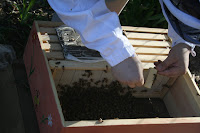 After getting the honey from the hive into a bucket, I needed to bottle the honey for distribution. Honey can be stored in food-grade plastic or stainless-steel air-tight containers for a very long time (centuries in some extreme cases). It shouldn't be stored in containers of other metals because the honey's acidity will oxidize the metal.
After getting the honey from the hive into a bucket, I needed to bottle the honey for distribution. Honey can be stored in food-grade plastic or stainless-steel air-tight containers for a very long time (centuries in some extreme cases). It shouldn't be stored in containers of other metals because the honey's acidity will oxidize the metal.We purchased a few 5-gallon buckets and a "honey-gate" - a valve that is screwed onto a hole cut into the bottom of the bucket. The honey gate is designed so that it is easy to quickly change the flow from the bucket which allows bottle fillers (me) to avoid overflowing the bottles.
First, I put a cardboard box under the honey gate to catch all the drips. As well as the honey gate is designed, it isn't perfectly drip-free, and when dealing with honey you have to assume that everything you touch will be sticky at the end. My wife hates a sticky kitchen, and she seemed a bit relieved when she noticed that the honey was dripping into the box and not onto the floor!
I rinsed and dried the food-grade PET bottles, and then just filled them with honey up to the neck. Then I tightly screwed on the plastic cap along with a paper seal. The seal seems to have a bit of adhesive around the rim and helps to keep the jar air-tight. Finally, I wiped off each bottle to remove the honey that inevitably gets on the outside of the jar, and the honey was ready to meet a consumer!
Out of curiosity, I weighed a few of the bottles and found that I was adding more than 1/2 lb. in the 1/2 lb. bottles after subtracting out the weight of the empty bottles. I did measure my honey at only 17% water content which would make my honey slightly heavier than the 18.6% water limit for honey, but I doubt that accounts for all of the difference. Of course, honey from different locations has different proportions of different kinds of sugar as well as differing water content, so it doesn't particularly surprise me that they're a bit heavy filled up to the neck. It's also possible that I was overfilling them. While I think they look best when filled to the neck (not the brim), large operations probably use bottling machines that fill by weight -- but then they probably have bottles that are designed for their average honey density and don't have to accommodate the variation in hobby apiarists world-wide.
















